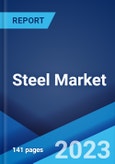Steel is a hard, strong grey or bluish-grey alloy produced by combining vital ingredients with iron and various elements. It is commonly available in flat and long steel variants. It is manufactured by melting raw materials, such as coal, iron ore and lime in a blast furnace and removing impurities. Steel is commonly used for the manufacturing of utensils, electrical cable trays, machines crews and hinges. It enhances toughness, design flexibility, tensile strength, anti-corrosion properties and malleability and improves overall shelf life. In comparison to iron, steel can efficiently be designed and molded in various forms to offer enhanced shape with a wide range of dimensions and extreme purity. As a result, steel finds extensive application across various industries, such as automotive, manufacturing and construction.
Steel Market Trends:
Significant growth in the automotive industry across the globe is creating a positive outlook for the market. Steel is widely used in the production of automobile structures, such as doors, engines, trunk closures, braking systems, fuel tanks, gears steering and braking systems. In line with this, the increasing demand for flat steel by automobile manufacturers to enhance fuel efficiency and reduce the overall weight of the vehicles is favoring the market growth. Moreover, various technological advancements, such as the integration of artificial intelligence (AI) and the development of rolling and casting techniques that assist in improving steel production methods to create designs that are resistant to pressure, temperature and corrosion, are providing an impetus to the market growth. Additionally, the widespread product adoption in the construction industry due to its properties, including ductility and durability, thus making the buildings earthquake-resistant, is positively impacting the market growth. Other factors, including the increasing product demand for manufacturing military aircraft and extensive infrastructural developments across the globe, are anticipated to drive the market toward growth.Key Market Segmentation:
The publisher provides an analysis of the key trends in each sub-segment of the global steel market report, along with forecasts at the global, regional and country level from 2023-2028. The report has categorized the market based on type, product and application.Breakup by Type:
- Flat Steel
- Long Steel
Breakup by Product:
- Structural Steel
- Prestressing Steel
- Bright Steel
- Welding Wire and Rod
- Iron Steel Wire
- Ropes
- Braids
Breakup by Application:
- Building and Construction
- Electrical Appliances
- Metal Products
- Automotive
- Transportation
- Mechanical Equipment
- Domestic Appliances
Breakup by Region:
- North America
- United States
- Canada
- Asia-Pacific
- China
- Japan
- India
- South Korea
- Australia
- Indonesia
- Others
- Europe
- Germany
- France
- United Kingdom
- Italy
- Spain
- Russia
- Others
- Latin America
- Brazil
- Mexico
- Others
- Middle East and Africa
Competitive Landscape:
The competitive landscape of the industry has also been examined along with the profiles of the key players being ArcelorMittal S.A., EVRAZ plc, Gerdau S.A., Hyundai Steel Co. Ltd, JFE Steel Corporation (JFE Holdings Inc.), Jiangsu Shagang Group Co. Ltd, Nippon Steel Corporation, Nucor Corporation, Shougang Group Co. Ltd., Tata Steel Ltd. (Tata Group), thyssenkrupp AG and United States Steel Corporation.Key Questions Answered in This Report
1. What was the size of the global steel market in 2022?2. What is the expected growth rate of the global steel market during 2023-2028?
3. What are the key factors driving the global steel market?
4. What has been the impact of COVID-19 on the global steel market?
5. What is the breakup of the global steel market based on the type?
6. What is the breakup of the global steel market based on the product?
7. What is the breakup of the global steel market based on application?
8. What are the key regions in the global steel market?
9. Who are the key players/companies in the global steel market?
Table of Contents
Companies Mentioned
- ArcelorMittal S.A.
- EVRAZ plc
- Gerdau S.A.
- Hyundai Steel Co. Ltd
- JFE Steel Corporation (JFE Holdings Inc.)
- Jiangsu Shagang Group Co. Ltd
- Nippon Steel Corporation
- Nucor Corporation
- Shougang Group Co. Ltd.
- Tata Steel Ltd. (Tata Group)
- thyssenkrupp AG
- United States Steel Corporation.
Methodology

LOADING...
Table Information
| Report Attribute | Details |
|---|---|
| No. of Pages | 141 |
| Published | September 2023 |
| Forecast Period | 2022 - 2028 |
| Estimated Market Value ( USD | $ 907 Billion |
| Forecasted Market Value ( USD | $ 1077 Billion |
| Compound Annual Growth Rate | 2.9% |
| Regions Covered | Global |
| No. of Companies Mentioned | 12 |









